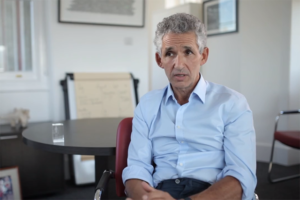Genetics of Wild Mice Behavior
Biologist Hopi Hoekstra on the extended phenotype, structure of mice burrows, and addiction encoded in genome
How does 3D bioprinting work? What are the major challenges facing it? Harvard-MIT Professor of Medicine and Health Sciences and Technology, Ali Khademhosseini, explains how printers could one day be used in the operating room.
One of the major issues with tissue engineering is to try to make tissues that have the right function. So, when you look at inside the body, the tissues have very particular architecture, which is basically different cell types coming together and organizing something that has a very specific architecture that helps with the function of that particular tissue. So, for example,in the heart you have the cells that organized the muscle tissue, and they’re aligned, and based on their alignment you get there a specific function to heart. In the liver you have cells that come together and form a little hexagonal structure so-called liver lobules that help with the function of the liver. So, the architecture of the tissue is very important in its function.
So, with 3D printing, this 3D manufacturing approach, what you are trying to do is to put cells and materials together in a way that recreates that specific architecture. So, this concept of 3D printing has been around for a long time in the area of mechanical engineering and manufacturing, where the idea has been to take models of three-dimensional objects to program in a computer and then literally use a printer to built things on top of each other. So, this concept was more and more applied to different areas, and including in the area of biology to making tissues. So, the concept has been around for a long time in different areas, andin the past, I would say, a couple of decades has been adapted to tissue engineering, and more and more has been utilized. Now, the general idea with this concept, it typically relies on taking cells and materials. So, previous approaches have started with taking normal printers, like inkjet printers that we have for printing on paper, and then, instead of having the ink inside people, put cells and gels and then started to print.
More and more, as technology developed, there are more advanced printers that are designed for actually making this; there are now actually commercial printers that are designed for printing cells and materials. Now, as people start making these,then there are other challenges that they have to overcome, for example, how do you keep the cells alive, while you printing them, how do you, once they are printed, how do you actually mature these tissues,so that they have the right function, and then, how do you start into interfacing other things into them. This is where the field is right now, people are trying to address some of these problems, of course, once some of these challenges are solved, the field has a lot of applications in different things. So, in the future it is conceivable that 3D manufacturing of 3D printers could be a part of operating rooms, where a surgeon or a clinical person can actually image the defect, and once you have an image of the defect site, then you can actually put that on a computer, and the computer can tell you what kind of 3D printed tissue you need, with what kind of architecture, so that you can fill the defect, and it is possible that you may even be able to print directly in the operating room in the patient, so that you have the right kind of 3D structure of the tissue that you want made
Now these are all in the future, but I think there are a lot of opportunities in this area and it is currently a very active area of research.
So, some of the major obstacles in 3D printing are things associated with being able to create the right kind of structures and also where do you get the right of materials that you are going to print from. So, with respect to creating the right kind of structures, I think there are technologies that you can take, which actually can print stuff in 3D, but the idea is there are not really the right kinds of structures often. So, often when you are printing in 3D, you start with two-dimensional layers that you print on top of each other. Now, that is OK maybe for some areas, but for a biological tissue, where you need the cells to remain viable, sometimes it doesn’t work that you leave something outside the body, outside the environment that the cells are used to, for many hours, while you continue printing. So, some other challenges are related to how we develop the right kind of printing technology that the cells can be printed, they can be happy and things related to that. There are also challenges, regarding, what exactly are you going to print, so there are challenges about what kind of materials we want to print, that the cells would be happy, and what kind of cells we want to print, whether we want to print mature cells, that are fully differentiated of whether we want to print more primitive cells, like stem cells, and then be able to subsequently mature them. There are other challenges, for example, how do we have the right kind of dimensions, do we need to print with the resolution of a single cell, do we need to print with the resolution of multiple cells, and then allow these cells to self-assemble and get the right kind of architecture and function. So, some of those questions are still not clear. And also there are other challenges, for example, regarding, once you have the things printed, then how do you actually use it in a clinical setting, to what level of function do you need to have these tissues before you actually use them, and whether it is something that can be printed inside the body or printed outside the body and implanted, can further mature inside the body. So, there are a lot, I think, technical challenges, a lot of scientific challenges with this field.
The major differences between 3D printing and 3D bioprinting or really a 3D printing applied to biological issues, is often the kind of the inks that you will use. So, with respect to 3D bioprinting, you want to have inks that are more biological, and they involve things like cells and gels. So, obviously the type of manufacturing, the types of nozzles and the types of conditions you need to print them are going to be very different from a 3D printer that is used to make an airplane part. So, I think that is the, major challenge. In the other hand,sometimes it isthe resolution: you may want to have more or less of a resolution, and some technologies are based on the specific applications that you are using.
So, I think there are two types of challenges with respect to applying these technologies, and whether the real challenges are more theoretical and more kind of engineering things, one is that with a lot of this tissue engineering type approaches there are a lot of scientific challenges that are left, which are really about, even if you have the cells and even if you tried to put them in gels, how do you really control the right kind of biological signals and the right kind of biophysical signals, so that it directs the cells, and I think that challenges are still existing in 3D printing. And then there are technological aspects, as well, which is related to the manufacturing process, the kind of feasibility, stability, reproducibility of all those things, and I think people are trying to address them.
One of the approaches, that people have tried to use to make 3D printing more useful is actually taking the cells and some of the jelly-like materials out of the equation, to be able to actually print materials. Lets say,those are just degradable materials, degradable plastics of a particular shape, that you can just implant, and that would make things easier, because you do not have to worry about the cells, and once those 3D printed materials are implanted, then the cells of the body can start remodeling them. There are also a lot of applications of 3D printing, again, without cells, that are used to make medical implants, like metal hip joints, and, you know, those kind of things, that actually normally you would use other manufacturing techniques to make those kind of prostheses, but now with the 3D printing you can make them specialized to the person.
So, there are a lot of challenges, and people are trying to both solve the challenges and then to avoid somebody’s challenges by coming up with different ways in which we would use 3D printing in medicine.
So, with respect to 3D printing, it is a of course a very difficult problem, that requires understanding and people from all kinds of disciplines. So, in 3D printing area applied to tissue engineering and regenerative medicine, you need a range of different expertise, you need a mechanical engineers and electrical engineers who understand the technology of printing, you need material scientist who understands the materials, that are being printed, you need the biologists, which understand the cells, and you need other kinds of engineers who understand other aspects of the materials, you need a clinician and doctors to be able to transplant it. So, it is a very, I would say, a diverse and multidisciplinary research area, that many different types of people can work together. Another couple of areas, which are very relevant to this: one is related to computational people, that actually can understand a computational models of having three-dimensional objects and designing them; and then the other one is imaging people, people who can actually image even inside the body or outside the body and then be able to take those imaging constructs with the different types of medical imaging modalities, and be able to translate them, those two things that can be used in 3D printing.
I think the future of 3D printing in the next few years will initially be based on things that are simpler, so, with respect to simpler things we need to see what things require us to have the “tunability” of the final construct that we want. And, in many medical applications where you have prosthetic devises, like implants of different sorts, you really need customizable sizes, customizable shapes, and that is where initially the 3D printing will be the most useful. Now, whether it is going to be done at the operating room of whether it is going to be done at a company, and then ship these things with the specified design, I think, that is yet to be determined. And then the timeline, I think, is still going to be determined; it is going to be much shorter than some of the more challenging things. With respect to the challenging things, for example, being able to make our hearts, or a liver, or a neural system that is 3D printed, I think, we are looking at things that are more challenging, and it is going to take more time, and it is going to require more development of both science and engineering aspects to make it done and those are, I think, really the things that are very interesting scientifically and sometimes clinically, but it is going to be more challenging to do, it is going to be a longer horizon.

Biologist Hopi Hoekstra on the extended phenotype, structure of mice burrows, and addiction encoded in genome

Physicist Markus Morgenstern on weak topological insulators, 2D materials, and spin pumping

Biologist Tim Spector on how microbes determine obesity, the best kind of diet, and the reasons to refrain fro...